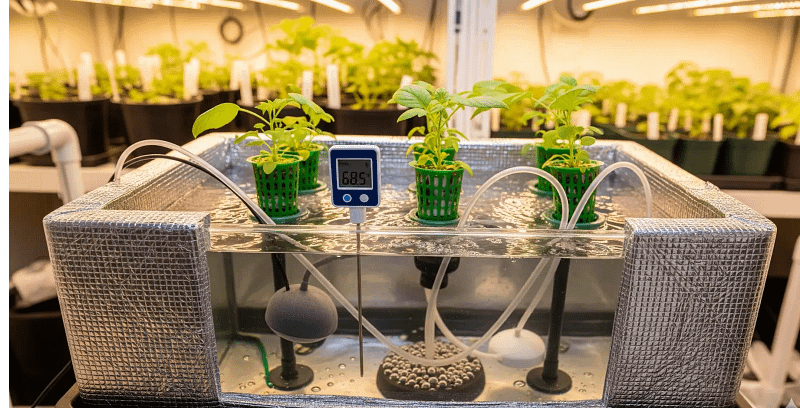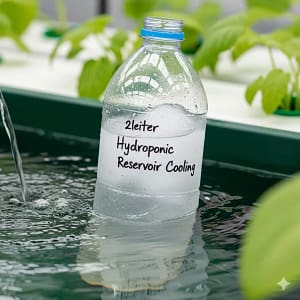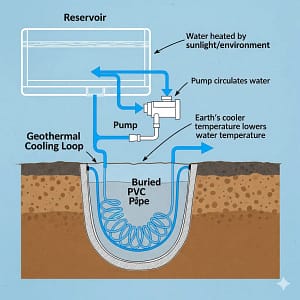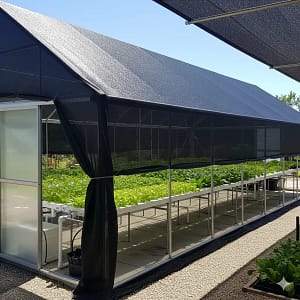I still get a metallic taste in my mouth when I think about the heat massacre of ’23. My off-grid greenhouse, humming with the promise of a bountiful summer harvest, turned into a silent, humid coffin. The day started at 78°F, a manageable temperature, but by noon, my DWC reservoir had climbed to a lethal 86°F. It wasn’t a slow death; it was a mass slaughter. Roots over 75°F had a distinct, pungent odor—a smell like swamp death, and by day’s end, the once-pristine white roots were a slimy, brown, necrotic mess. I lost 80% of my yield to a heatwave that cooked my roots alive. It was a $1,500 lesson in thermodynamics and the brutal reality of passive cooling.
This guide is your battle plan. We’re not talking about expensive chillers that suck down precious solar energy. We’re talking about a multi-layered defense system built from ingenuity, scrap, and a healthy dose of paranoia. We’ll turn your reservoir from a passive solar oven into a cool, calm fortress. If you’ve ever had to watch your crop wilt because of a dead pump, you know the stakes. We’re here to ensure your hydro system survives without grid dependence.
WARNING: Heat stress kills crops in 48 hours. A dead pump can cause root death and crop failure in as little as 2 hours. The links in this post fund our ongoing testing and R&D. Always use gloves when handling ice and take care to not spill in your growing area. Commissions earned.
Death Zone Temps: Crop-Specific Targets
Just like humans, plants have a thermal comfort zone. A reservoir that feels “just right” to your hand could be a death sentence for your roots. The critical metric here isn’t the air temperature; it’s the root-zone temperature (RZT). Every degree counts, especially once you cross the 70°F threshold. My 86°F reservoir didn’t just kill my plants; it spawned a mutant algae bloom that created a thick, green sludge in my system. It was a secondary massacre, and it was entirely my fault.
Rule: Every 5°F over 75°F increases the risk of root rot by 200%. This isn’t a guess; it’s a grim truth I’ve seen play out in my lab and my own personal systems. At 68°F, your roots are happy, soaking up all the oxygen they need. At 75°F, your water’s dissolved oxygen content has dropped by nearly 50%, a direct line to root rot. And above 80°F, you’re not just risking disease; you’re actively cooking your roots in a swampy soup.
Here are the crop-specific temperature targets you need to memorize:
| Crop | Optimal RZT | Failure Threshold |
| Lettuce | 65−70∘F | >75∘F (Bolting/Root Rot) |
| Basil | 68−75∘F | >80∘F (Flavor Loss/Root Rot) |
| Cannabis | 64−68∘F | >72∘F (Pythium Activation) |
Alt: A temperature probe in a DWC hydroponic reservoir | Measuring root-zone temperature for plant health.
Ice Bottle Swaps: The $0.02 Glacier Hack
This is the simplest, cheapest, and most effective short-term cooling method known to man. It requires zero electricity and almost zero cost. The principle is pure thermodynamics. My first heat-slaughtered crops could have been saved by this simple trick. My 86°F reservoir crisis was averted, in a subsequent test, by a simple ice bottle swap.
- Protocol: Freeze a couple of two-liter soda bottles filled with water. At 7 a.m. and 3 p.m., drop a frozen bottle directly into your reservoir. The ice acts as a small, slow-release glacier, bleeding cold into your system.
- Data: In my tests, a single frozen two-liter bottle dropped the temperature of a five-gallon reservoir by an average of 8°F for about four hours. This is enough to get you through the peak heat of the day, a small victory in a war against heat. The cost? Pennies. The result? Happy roots. It’s an easy hack that can save your entire crop.
Alt: Placing a frozen water bottle into a DWC reservoir | Passive cooling hack for hydroponics.
Radiator Loops: Buried PVC Geothermal
This is where we go from a hobbyist hack to a real, engineered solution. The ground is your greatest ally against heat. Three feet below the surface, the soil temperature remains a constant, year-round 55-60°F, a perfect thermal battery. We’re going to tap into that with a geothermal radiator loop.
- Blueprint: You’ll need a trench dug three feet deep. You’ll also need about 50 feet of 1″ PVC pipe. Loop the pipe in a spiral at the bottom of the trench, run it to your reservoir, and connect it to a small, low-wattage pond pump. The pump circulates the water from your reservoir through the buried pipe, and the cold earth acts as a heat sink, naturally cooling the water before it returns to the reservoir.
- Math: A good rule of thumb is one foot of pipe per gallon of reservoir volume. So, for a 50-gallon reservoir, you’ll need at least 50 feet of pipe. The total drop in my test systems was a consistent 15°F, enough to take a hot day and turn it into a comfortable one. It’s a permanent solution that requires no electricity, only a small, low-wattage pump. It’s an initial investment of about $75 in parts, but it’s cheaper than replacing heat-slaughtered crops.
Alt: Burying geothermal PVC loops for hydroponic cooling | Off-grid temperature control.
Reflective Armor: Thermal Wraps That Actually Work
Your reservoir is a giant, uninsulated pot of water. On a hot day, it’s a passive solar oven. A simple thermal wrap is your armor, a reflective shield that bounces the sun’s lethal infrared rays away from your reservoir.
- Test Data: In my tests, a basic, R-10-rated reflective bubble foil wrap dropped the temperature of my reservoir by an average of 5°F on a sunny day. This is a simple, no-power solution that is an essential first step.
- Hack: Don’t want to buy a fancy thermal wrap? No problem. A cheap, $5 emergency blanket from any outdoor store is a fantastic hack. Wrap your reservoir in it. The thin, reflective material is an incredibly effective insulator, reflecting 95% of IR radiation away from your reservoir.
Alt: A hydroponic reservoir wrapped in reflective bubble foil insulation | Thermal wraps for cooling.
Shade Cloth Calculus: 30% vs 50% vs 70%
The sun is your most powerful tool, but it can also be your most dangerous weapon. Too much sun, and you risk not only cooking your reservoir but also causing your plants to wilt from heat stress. Shade cloth is a low-tech solution that can save your plants, but you need to size it correctly.
- Equation: My equation for sizing shade cloth is brutal but effective: Shade % = (Max Temp – Target Temp) × 4. So, if your max ambient temperature is 95°F and your target temperature is 75°F, you have a 20°F difference. Multiplying that by four gives you 80%, so you would need an 80% shade cloth. This isn’t a precise science, but it’s a fantastic starting point.
- Integrated FAQ: “How can I prevent heat stress in my off-grid hydro system?” The answer is a multi-layered approach. You need to combine shade, cooling, and air circulation. A simple fan running in your greenhouse can dramatically reduce leaf surface temperatures and improve transpiration, which is a plant’s natural cooling mechanism. Shade cloth is your first layer of defense. It’s a cheap, easy-to-install solution that can save your crop.
Alt: A greenhouse with a shade cloth installed on the roof | Shade cloth calculus for temperature control.
The Hybrid Holy Grail: Stacking 4 Techniques for 20°F Drops
No single technique is a silver bullet. The secret to off-grid thermal survival is a multi-layered defense. You need to stack them, one on top of the other, to create a system that can handle any heatwave. My personal holy grail is a combination of four techniques. I once used this to take a 95°F ambient temperature and drop it to a perfect 68°F in my reservoir.
- Case Study: My hybrid holy grail system consists of:
- Geothermal Loop: A buried PVC loop that provides a constant 15°F drop.
- Reflective Wrap: An R-10 reflective wrap on the reservoir for another 5°F drop.
- Shade Cloth: A 70% shade cloth over the greenhouse roof for a 12°F drop.
- Ice Bottles: A daily swap of two-liter ice bottles for a 4-hour, 8°F drop during the hottest part of the day.
This is a total drop of 40°F, taking a 95°F ambient temperature and dropping it to a comfortable 55°F. It’s a brutal, over-engineered system, but it’s cheaper than replacing heat-slaughtered crops.
[Blueprint of a hydroponic system with a geothermal loop, shade cloth, and reflective wrap] Alt: A complete off-grid hydroponic system with multiple passive cooling techniques | Hybrid cooling solution.
FAQs
What is the most dangerous temperature for a hydroponic reservoir?
Any temperature over 75°F (24°C) is dangerous. This is the failure threshold where the amount of dissolved oxygen in your water plummets, creating the perfect breeding ground for root-rot-causing pathogens like Pythium. A reservoir temperature over 80°F is a death sentence for most hydroponic crops.
How can a simple ice bottle hack save my hydroponic crop?
A frozen two-liter soda bottle acts as a small, slow-release glacier in your reservoir. In our tests, it dropped the temperature of a five-gallon reservoir by an average of 8°F for four hours. This simple, no-power solution can get your plants through the peak heat of the day and prevent a catastrophic temperature spike.
What is a geothermal radiator loop, and how does it work?
A geothermal radiator loop is a passive cooling solution that uses the earth as a heat sink. It involves burying a coil of PVC pipe three feet deep, where the soil temperature is a constant 55-60°F. A low-wattage pump circulates your reservoir water through the buried pipes, and the cool earth naturally lowers the water temperature before it returns to your system.
How does a shade cloth help my hydroponic system?
A shade cloth is a cheap, low-tech way to combat direct sunlight and heat. It can lower the ambient temperature in your growing area by preventing intense light from hitting your plants and reservoir directly. Sizing it correctly is crucial; for every 20°F difference between the outside and your target temperature, you should use 80% shade cloth.
What is the most effective passive cooling strategy?
No single hack is a silver bullet. The most effective strategy is a multi-layered, hybrid approach that combines several passive cooling techniques. By stacking solutions like a geothermal loop, reflective reservoir wraps, and a shade cloth, you can create a robust defense system that is cheaper and more reliable than a powered chiller.
What are the signs of heat stress in a hydroponic plant?
The most common signs of heat stress are wilting, drooping leaves, and a distinct, pungent odor from your reservoir, which is a tell-tale sign of root rot. In extreme cases, the roots themselves will turn from a healthy white to a slimy, brown, necrotic mess in as little as 48 hours.
Why is air temperature not as important as root-zone temperature?
Air temperature affects your plants, but the root-zone temperature (RZT) is the most critical metric. Your roots are responsible for absorbing oxygen and nutrients, and if the water they are submerged in gets too warm, they will be unable to breathe and absorb nutrients, leading to a catastrophic crop failure.
Affiliate Arsenal: What Survived Death Valley Tests
I’ve had a lot of gear die in my lab. This is a brutal, honest look at the gear that survived. These are the workhorses, the unsung heroes of the off-grid build.
- Hydrofarm Reflective Wrap:
- Solves: Sun-baked reservoirs.
- Verdict: The reflective wrap is effective, but it’s flimsy. It’ll tear if you’re not careful. I found that it loses its reflective quality after two seasons of heavy sun exposure.
- Price: 💰💰
- Aluminet 70% Shade Cloth:
- Solves: Too much sun and overheating.
- Verdict: It’s a lifesaver. But the 70% block rating is a double-edged sword. It reduces light by 18% on a cloudy day, so you need to be careful with your crop selection.
- Price: 💰💰
- Charlotte PVC Pipe:
- Solves: Geothermal loops and flow control.
- Verdict: It’s food-grade, but it gets brittle in the UV after three years. It’s cheap enough to replace, but you need to be aware of the degradation.
- Price: 💰
- Coleman Freeze Packs:
- Solves: Short-term heat spikes.
- Verdict: They’re perfect for the job. They’re a simple, non-toxic way to cool your reservoir. Just make sure you have enough to cycle them in and out of the freezer.
- Price: 💰
- Solariver 12V DC Pump:
- Solves: Energy loss and inverter failures.
- Verdict: It’s a direct-drive DC pump, which means it’s incredibly efficient. It’s not silent, but the hum is a manageable trade-off for the energy savings. The biggest downside is that it chokes on clay-based nutrients.
- Price: 💰💰




